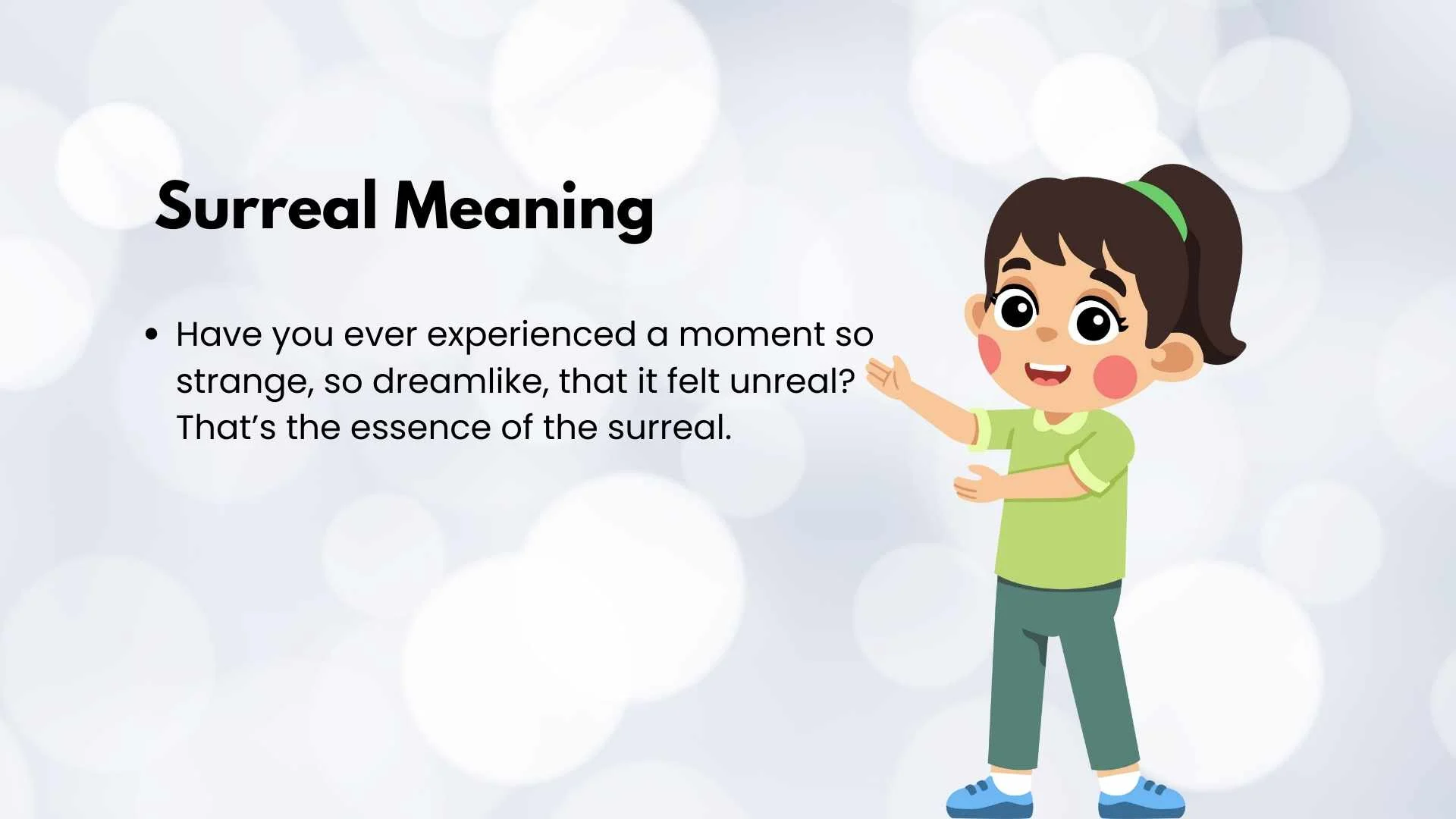Have you ever experienced a moment so strange, so dreamlike, that it felt unreal? That’s the essence of the surreal.
Rizz Line Generator
Whether in art, literature, or even everyday life, surrealism invites us to explore beyond the ordinary, into the mysterious interplay of the conscious and unconscious mind.
This article dives deep into surrealism, its history, key figures, techniques, themes, and its lasting influence on culture worldwide.
Introduction to Surrealism and Surreal Meaning
The term surreal originates from the French word surréaliste, meaning “beyond reality.” A surreal moment meaning could range from seeing a bizarre dream sequence unfold in a painting to experiencing a personal event that feels like it defies logic. Surrealism isn’t just an art style—it’s a philosophy, a window into fantasy, dreams, and the creative imagination.
Emerging after World War I, Surrealism grew as a response to the horrors of conflict, a rebellion against rationalism, and a search for deeper truths in European culture. By challenging traditional perspectives, it redefined both visual art and literature, introducing ideas that remain influential today.
Origins and Definition of Surrealism
The Surrealist movement officially began in the early 1920s, spearheaded by André Breton, who authored The Surrealist Manifesto (1924). Breton described Surrealism as “psychic automatism in its pure state,” emphasizing the direct exploration of the unconscious mind without censorship or rational control.
Before Surrealism, the Dada movement had already questioned conventional art, embracing anti-art and absurdity. Dada’s irreverence laid the groundwork, but Surrealism took it further, blending psychological theory, dreams, and fantasy into art and literature.
Key Concepts:
- Liberation from conscious constraints
- Emphasis on chance, spontaneity, and psychic investigation
- Fusion of reality and dreamlike imagination
Core Principles of Surrealism
At its heart, Surrealism seeks to reconcile the conscious mind with the unconscious mind. Its techniques and expressions allow artists and writers to explore:
- Dreams and fantasy as central sources of inspiration
- Metamorphosis, transforming objects, people, and landscapes into new forms
- Juxtaposition of words in literature to evoke unexpected meanings
- Grotesque images that challenge conventional perception
By embracing irrationality and the unknown, Surrealism celebrates the positive expression of human imagination, allowing artists to explore inner realities in striking ways.
Surrealism in Visual Art
Visual art is perhaps the most famous outlet for Surrealism. Artists translated dreams and fantasies into vivid, sometimes disturbing imagery.
Major Artists and Works:
| Artist | Notable Work | Technique / Contribution |
|---|---|---|
| Salvador Dalí | The Persistence of Memory (1931) | Melting clocks, dreamlike landscapes |
| Max Ernst | Forest and Sun (1927) | Developed frottage and grattage techniques |
| René Magritte | The Treachery of Images (1929) | Absolute Surrealism, symbolic imagery |
| Joan Miró | The Farm (1921–22) | Organic Surrealism, biomorphic forms |
| Meret Oppenheim | Object (1936) | Assemblage art using found objects |
| Dorothea Tanning | Birthday (1942) | Dreamlike, uncanny scenes |
| Kay Sage | Tomorrow Is Never (1955) | Barren landscapes and architectural precision |
| Leonora Carrington | The Lovers (1937) | Occult imagery, fantasy themes |
| Eileen Agar | Angel of Anarchy (1937) | Collage, surreal symbolism |
Techniques in Surrealist Visual Art
Surrealist artists often experimented with methods to bypass the rational mind:
- Automatic Drawing: Recording spontaneous images without conscious control
- Frottage Technique: Rubbing pencil over textured surfaces (Max Ernst)
- Grattage Technique: Scraping paint over textures to reveal unexpected forms (Max Ernst)
- Exquisite Corpse: Collaborative drawing creating unexpected results
- Assemblage Art: Combining found objects into surreal compositions (Meret Oppenheim)
These techniques emphasize chance, spontaneity, and psychic response, revealing the inner workings of the mind.
Surrealism in Literature
Surrealist literature mirrors the movement in visual art, exploring dreamlike narratives and the unconscious mind. Writers employed:
- Juxtaposition of words to generate unexpected meaning
- Automatic writing for unfiltered expression
- Themes of fantasy, erotic symbolism, and metamorphosis
Key Literary Figures:
- André Breton: poet, critic, and Surrealist manifesto author
- Paul Éluard: French Surrealist poet
- Pierre Reverdy: French poet exploring dreams and subconscious thought
Surrealist literature influenced modern storytelling, magical realism, and contemporary poetry, demonstrating how language can evoke the surreal beyond conventional meaning.
Surrealist Concepts and Themes
Surrealism revolves around exploring the hidden mind and reshaping reality. Key concepts include:
- Unconscious Mind: The primary source of inspiration for dreams, fantasy, and creativity
- Surreality: The fusion of conscious and unconscious realms
- Alien or Dreamlike Worlds: Irrational, fantastical settings
- Biomorphic Imagery: Organic, abstract shapes suggesting life or transformation
- Symbolic Imagery & Alchemy: Mystical and often occult references in art
Themes often include: grotesque images, barren landscapes, marine invertebrates in art, erotic symbolism, metamorphosis, and dreamlike scenes.
Surrealism Movements and Styles
Surrealism evolved into several distinct styles:
- Organic Surrealism: Fluid, biomorphic forms (Jean Arp, Max Ernst, Joan Miró)
- Absolute Surrealism: Precisely executed, rationally inexplicable forms (René Magritte, Dalí)
- Dadaism: Precursor anti-art movement emphasizing absurdity and chance
- Cubism Influence: Contrasted with formalistic approaches to composition
These substyles allowed Surrealists to experiment across mediums, from painting to sculpture, and expand European avant-garde sensibilities.
Influences from Historical Artists
Early artists inspired Surrealism through symbolic, dreamlike, and fantastical imagery:
- Hieronymus Bosch: Complex, grotesque imagery in religious contexts
- Francisco Goya: Dark, psychological depictions of human suffering
- Odilon Redon: Visionary painter bridging Symbolism and Surrealism
- Giorgio de Chirico: Precursors of metaphysical, eerie landscapes
- Marc Chagall: Dreamlike, floating figures in colorful scenes
Their work helped define the Surrealist vocabulary of fantasy, metamorphosis, and symbolic imagery.
Surrealism Around the World
While originating in France, Surrealism spread internationally:
- USA: Salvador Dalí’s works featured in the Museum of Modern Art (MoMA), New York
- UK: Dorothea Tanning and Eileen Agar at Tate Modern, London
- Chicago: Max Ernst pieces in the Art Institute of Chicago
- Mexico, Germany, Belgium: Home to notable Surrealist artists and exhibitions
Additionally, exploring surreal meaning in Urdu, Bengali, Tamil, and English helps global audiences connect with the concept beyond the Western canon.
Surrealism in Everyday Life
Surrealism isn’t confined to museums. You might experience it in:
- A dreamlike street scene that feels “it feels surreal”
- Reading a novel with unexpected juxtaposition of words
- Seeing a bizarre art installation or film sequence
It challenges perception, encourages creative imagination, and expands how we interpret the world.
Common Questions:
- Surreal meaning antonyms: literal, mundane, realistic
- Surreal spelling: S-U-R-R-E-A-L
- How to distinguish bizarre meaning vs. surreal meaning
- Recognizing a surreal moment meaning in your life
Legacy and Modern Influence
Surrealism continues to influence:
- Film and photography: Dreamlike sequences, symbolic imagery
- Digital media and advertising: Unexpected juxtapositions and fantasy elements
- Contemporary art: Assemblage, biomorphic abstraction, interactive installations
- Feminist contributions and scholarship, such as Whitney Chadwick’s Women Artists and the Surrealist Movement (1985), highlight the role of women artists in shaping the movement
Surrealism remains a vibrant framework for psychic investigation, chance, and imaginative experimentation.
Conclusion
Surrealism bridges dream and reality, combining the conscious with the unconscious. Through visual art, literature, and innovative techniques, it reshapes perception and inspires creative imagination. From Dalí’s melting clocks to Carrington’s mystical worlds, Surrealism invites you to explore life through a lens where anything feels possible, and even the bizarre can make sense.
Next time something feels it still feels surreal, take a moment to notice the Surrealist spark in your own world—it’s everywhere, waiting for your imagination.
Suggested Visuals and Tables
Table: Techniques and Artists
| Technique | Artist Example | Description |
|---|---|---|
| Automatic Drawing | André Breton | Spontaneous uncensored creation |
| Frottage Technique | Max Ernst | Rubbing textures to create patterns |
| Grattage Technique | Max Ernst | Scraping paint over textures |
| Exquisite Corpse | Surrealists collectively | Collaborative, unexpected compositions |
| Assemblage Art | Meret Oppenheim | Using found objects in new contexts |
Timeline: Surrealist Movement (1916–1960s)
- 1916: Dada movement begins in Zurich
- 1924: André Breton publishes The Surrealist Manifesto
- 1930s: Dalí and Magritte rise to international fame
- 1940s–1950s: Surrealism spreads globally, women artists gain recognition




